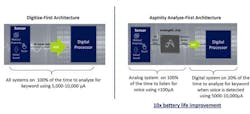What you’ll learn:
- Billions of smart devices rely on sensor data to gather intelligence.
- Most smart devices use a “digitize-first” model to digitize all sensor data immediately, sending data to high-power digital processors.
- “Digitize-first” wastes power processing mostly irrelevant data.
- A new alternative model, “analyze-first,” performs machine learning in analog using an analogML chip.
- AnalogML is a systems-level approach that can save up to 10X battery life in smart devices.
Billions of always-on intelligent devices are continuously sensing the environment for data—a voice command, the sound of glass breaking, or the vibrational frequency of a pump bearing on the factory floor. Traditionally, these devices have relied on the immediate digitization of the sensor data to determine if the data are important. However, this results in the wasteful processing of mostly irrelevant information, which dramatically reduces battery life in the end device.
Improving battery life in such devices requires embracing a technology that many of today’s engineers find both old-fashioned and intimidating: analog. That’s because working with raw, unstructured analog signals from the real word—namely, touch, vision, hearing, and vibration—is hard.
Since the introduction of the first digital integrated circuit, it’s been much simpler to create products that process sensor signals with familiar ones or zeroes, than to directly process the analog data that are sensed. That’s why always-on devices transform analog input into digital signals immediately, before doing almost anything else.
While digital has effectively solved processing challenges for the last 50 years, Moore’s Law is finally approaching a brick wall in the laws of physics. It’s pushing engineers to think outside the current digital data-processing paradigm and become more creative about designing efficiency into the always-on system.
Fundamentally, we need to use digital more strategically, engaging digital chips to do heavy processing only when necessary. This frees us to use analog chips to perform a first round of analysis that determines whether a specific event, such as voice or an acoustic trigger, is present while the sound data are still in their natural analog state.
In the case of a voice-enabled device, voice is the only important data, as a keyword will never be spoken if speech isn’t present. This systems-level, architectural approach allows the digital wake word engine to remain in low-power sleep mode until its higher-power, higher-resolution processing is actually needed for keyword verification.
Analyze First
This new, more efficient, cascaded approach to data analysis in always-on systems is achieved through analog machine learning (analogML). AnalogML chips can accurately detect acoustic triggers such as voice, window glass breaks, and smoke or other alarm tones using near-zero power while the microphone data are in their raw analog state, focusing overall system power only on important data.
For example, in a voice-enabled TV remote, voice may only be present 10% to 20% of the time, so the majority of the system can stay asleep until the wake-word engine is needed for keyword analysis. Since the digital system is off for at least 80% of the time in this analyze-first architecture, designers can achieve a dramatic increase in system efficiency—a 10X improvement in battery life.
Making Analog More Accessible
While the power-saving benefits of analog are obvious in this context, what can companies do if most of today’s engineers don’t have analog experience? A quick search on Indeed.com (run January 7, 2021) revealed 3,579 analog systems engineering jobs and 20,632 digital systems engineering jobs. While this represents a massive difference between analog and digital engineering experience (and demand for jobs), it doesn’t mean we need to sacrifice all of the benefits of analog design. It just means we need to make sure analogML can be used in a way that’s familiar to everyone.
That’s the model our company took in developing analogML chips. We made programmability a priority, providing algorithms for popular use cases such as voice and window-break detection, which reduces adoption barriers and speeds time-to-market for always-listening systems. The analogML development environment also has been designed for engineers without analog expertise, allowing them to easily build algorithms for customized applications through standard programming or training interfaces that they’re already accustomed to using.
AnalogML: The New Frontier
The analyze-first paradigm enabled by analogML is a major advance in design thinking. Instead of trying to save power through discrete parts, we can now think holistically about designing power- and data-efficient devices. Ideal for battery-powered voice-first and acoustic event-detection, analogML also can be used for industrial vibration monitoring and myriad other always-on applications.
By engaging a processing strategy that pulls a new level of intelligence into the analog domain, we pave the way to the design of thousands of new types of power-efficient always-on smart devices that focus power consumption on the data that actually matter.
References:
https://www.eejournal.com/article/a-brave-new-world-of-analog-artificial-neural-networks-aanns/
https://www.eetimes.eu/ramping-up-development-of-ultra-low-power-always-on-sensing/
https://www.techbriefs.com/component/content/article/tb/supplements/st/features/articles/36150

